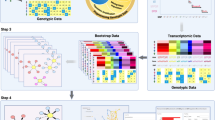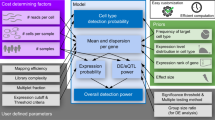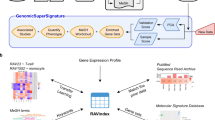Abstract
Ensuring reproducibility of results in high-throughput experiments is crucial for biomedical research. Here, we propose a set of computational methods, INTRIGUE, to evaluate and control reproducibility in high-throughput settings. Our approaches are built on a new definition of reproducibility that emphasizes directional consistency when experimental units are assessed with signed effect size estimates. The proposed methods are designed to (1) assess the overall reproducible quality of multiple studies and (2) evaluate reproducibility at the individual experimental unit levels. We demonstrate the proposed methods in detecting unobserved batch effects via simulations. We further illustrate the versatility of the proposed methods in transcriptome-wide association studies: in addition to reproducible quality control, they are also suited to investigating genuine biological heterogeneity. Finally, we discuss the potential extensions of the proposed methods in other vital areas of reproducible research (for example, publication bias and conceptual replications).
This is a preview of subscription content, access via your institution
Access options
Access Nature and 54 other Nature Portfolio journals
Get Nature+, our best-value online-access subscription
$29.99 / 30 days
cancel any time
Subscribe to this journal
Receive 12 print issues and online access
$259.00 per year
only $21.58 per issue
Buy this article
- Purchase on Springer Link
- Instant access to full article PDF
Prices may be subject to local taxes which are calculated during checkout



Similar content being viewed by others
Data availability
All processed data for simulations and real data analysis are available at https://github.com/ArtemisZhao/INTRIGUE/intrigue_paper. GWAS summary statistics for the UK Biobank and the GIANT consortium are available at https://doi.org/10.5281/zenodo.3629742. eQTL data for TWAS analysis are available at https://gtexportal.org/home/datasets.
Code availability
The source code for software implementation (in R and C/C++), simulation studies and real data processing are provided in https://github.com/ArtemisZhao/INTRIGUE. A Docker image that duplicates the complete computational environment for reproducing the reported results can be freely downloaded from https://hub.docker.com/r/xqwen/intrigue.
References
Goodman, S. N., Fanelli, D. & Ioannidis, J. P. What does research reproducibility mean? Sci. Transl. Med. 8, 341ps12–341ps12 (2016).
Begley, C. G. & Ioannidis, J. P. Reproducibility in science: improving the standard for basic and preclinical research. Circ. Res. 116, 116–126 (2015).
Leek, J. T. & Peng, R. D. Opinion: reproducible research can still be wrong: adopting a prevention approach. Proc. Natl Acad. Sci. USA 112, 1645–1646 (2015).
Leek, J. T. et al. Tackling the widespread and critical impact of batch effects in high-throughput data. Nat. Rev. Genetics 11, 733–739 (2010).
AC’t Hoen, P. et al. Reproducibility of high-throughput mrna and small rna sequencing across laboratories. Nat. Biotech. 31, 1015–1022 (2013).
Goh, W. W. B., Wang, W. & Wong, L. Why batch effects matter in omics data, and how to avoid them. Trends Biotech. 35, 498–507 (2017).
Ioannidis, J. P. et al. Repeatability of published microarray gene expression analyses. Nat. Genetics 41, 149–155 (2009).
Baggerly, K. A. & Coombes, K. R. et al. Deriving chemosensitivity from cell lines: forensic bioinformatics and reproducible research in high-throughput biology. Ann. Appl. Stats 3, 1309–1334 (2009).
Flutre, T., Wen, X., Pritchard, J. & Stephens, M. A statistical framework for joint EQTL analysis in multiple tissues. PLoS Genet. 9, e1003486 (2013).
Li, G., Shabalin, A. A., Rusyn, I., Wright, F. A. & Nobel, A. B. An empirical Bayes approach for multiple tissue eqtl analysis. Biostatistics 19, 391–406 (2017).
Consortium, G. et al. The genotype-tissue expression (gtex) pilot analysis: multitissue gene regulation in humans. Science 348, 648–660 (2015).
Goodman, S. N. A comment on replication, P-values and evidence. Stat. Med. 11, 875–879 (1992).
Heller, R., Bogomolov, M. & Benjamini, Y. Deciding whether follow-up studies have replicated findings in a preliminary large-scale omics study. Proc. Natl Acad. Sci. USA 111, 16262–16267 (2014).
Li, Q., Brown, J. B., Huang, H. & Bickel, P. J. et al. Measuring reproducibility of high-throughput experiments. Ann. Appl. Stats 5, 1752–1779 (2011).
Tukey, J. W. The future of data analysis. Ann. Math. Stats 33, 1–67 (1962).
Stephens, M. False discovery rates: a new deal. Biostatistics 18, 275–294 (2016).
Efron, B. et al. Size, power and false discovery rates. Ann. Stats 35, 1351–1377 (2007).
Leek, J. T. & Storey, J. D. Capturing heterogeneity in gene expression studies by surrogate variable analysis. PLoS Genetics 3, e161 (2007).
Johnson, W. E., Li, C. & Rabinovic, A. Adjusting batch effects in microarray expression data using empirical Bayes methods. Biostatistics 8, 118–127 (2007).
Gamazon, E. R. et al. A gene-based association method for mapping traits using reference transcriptome data. Nat. Genetics 47, 1091–1098 (2015).
Gusev, A. et al. Integrative approaches for large-scale transcriptome-wide association studies. Nat. Genet. 48, 245–252 (2016).
Zhang, Y. et al. PTWAS: investigating tissue-relevant causal molecular mechanisms of complex traits using probabilistic TWAS analysis. Genome Biol. 21, 232 (2020).
Storey, J. D. et al. The positive false discovery rate: a Bayesian interpretation and the q-value. Ann. Stats 31, 2013–2035 (2003).
Aguet, F. et al. The gtex consortium atlas of genetic regulatory effects across human tissues. Science 369, 1318–1330 (2020).
Peters, J. L. et al. Assessing publication bias in meta-analyses in the presence of between-study heterogeneity. J. Royal Stat. Soc. A 173, 575–591 (2010).
Lin, L. & Chu, H. Quantifying publication bias in meta-analysis. Biometrics 74, 785–794 (2018).
Terrin, N., Schmid, C. H., Lau, J. & Olkin, I. Adjusting for publication bias in the presence of heterogeneity. Stat. Med. 22, 2113–2126 (2003).
Augusteijn, H. E., van Aert, R. & van Assen, M. A. The effect of publication bias on the q test and assessment of heterogeneity. Psych. Meth. 24, 116–134 (2019).
Lau, J., Ioannidis, J. P., Terrin, N., Schmid, C. H. & Olkin, I. The case of the misleading funnel plot. BMJ 333, 597–600 (2006).
Higgins, J. P. & Thompson, S. G. Quantifying heterogeneity in a meta-analysis. Stat. Med. 21, 1539–1558 (2002).
Schmidt, S. Shall we really do it again? The powerful concept of replication is neglected in the social sciences. Rev. Gen. Psych. 13, 90–100 (2009).
Wen, X. Bayesian model selection in complex linear systems, as illustrated in genetic association studies. Biometrics 70, 73–83 (2014).
Wen, X. & Stephens, M. Bayesian methods for genetic association analysis with heterogeneous subgroups: from meta-analyses to gene-environment interactions. Ann. Appl. Stats 8, 176–203 (2014).
Acknowledgements
This work was supported by National Institutes of Health grant nos. R35GM138121, R01DK108805 and R01DK119380.
Author information
Authors and Affiliations
Contributions
Y.Z., M.G.S. and X.W. conceived the ideas. Y.Z. and X.W. designed the experiments. Y.Z. and X.W. developed methods, implemented software and performed analyses. Y.Z., M.G.S. and X.W. wrote the manuscript.
Corresponding author
Ethics declarations
Competing interests
The authors declare no competing interests.
Additional information
Peer review information Lin Tang was the primary editor on this article and managed its editorial process and peer review in collaboration with the rest of the editorial team.
Publisher’s note Springer Nature remains neutral with regard to jurisdictional claims in published maps and institutional affiliations.
Extended data
Extended Data Fig. 1 Proportion estimates from batch effect affected high-throughput experiments with no genuine biological signals.
Each simulated dataset consists of 1,000 genes. No gene is differentially expressed in the case (N = 20) and the control (N = 20) samples. In each replication dataset, 500 genes are affected by the unobserved batch effects with various magnitudes (η/σ). The figure shows the estimates of (πIR, πR) from the CEFN and the META models for all magnitudes of batch effects examined. The reproducible proportions across all datasets remain close to 0, while the estimates of the irreproducible proportions monotonically increases as the batch effects become stronger.
Extended Data Fig. 2 A directed acyclic graph representation of the proposed Bayesian hierarchical model.
The estimated effects, \({\hat{\beta }}_{i,j}\)’s are observed, \({\bar{\beta }}_{i}\)’s and βi,j’s are latent random variables. ω, k (or r) are hyper-parameters.
Supplementary information
Supplementary Information
Supplementary Table 1 and Notes.
Rights and permissions
About this article
Cite this article
Zhao, Y., Sampson, M.G. & Wen, X. Quantify and control reproducibility in high-throughput experiments. Nat Methods 17, 1207–1213 (2020). https://doi.org/10.1038/s41592-020-00978-4
Received:
Accepted:
Published:
Issue Date:
DOI: https://doi.org/10.1038/s41592-020-00978-4
This article is cited by
-
Microfluidic high-throughput 3D cell culture
Nature Reviews Bioengineering (2024)
-
Comparison between stone and digital cast measurements in mixed dentition
Journal of Orofacial Orthopedics / Fortschritte der Kieferorthopädie (2022)



